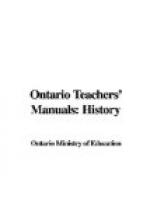These items are sifted from a great many suggested by the pupils. In the sifting process, a very useful discussion is had as to what constitutes real “news,” and what is mere “gossip”; that is, what is of value as news to the world at large, and what is of purely local, personal interest.
In civics, current topics may be made very useful. Items of municipal, provincial, or federal affairs furnish a concrete basis for the study of our system of government, and may also suggest moral examples.
LOCAL MATERIAL
One of the chief uses of local history in the class-room is to make the study of general history more vivid and interesting (1) by making more real those facts of history associated with the locality in which we live, and (2) by providing suitable illustrations, from the pupil’s own experience, of facts in general history. When a pupil has seen the place where an event of history has happened, he has an interest in that event that he could scarcely gain in any other way, and the history of that period may then be taught with more interest and profit to him. A pupil finds also in local history certain facts that he must understand in order to interpret the story of happenings, distant in time and place.
Some parts of Ontario are much richer in material than others, but in all historic spots may be found. On the St. Lawrence River, in the Niagara peninsula, in the Talbot settlement district, in York county, along the Ottawa River, in the Huron tract, there is no lack of useful material. But it is not necessary to confine such local history to the outstanding events of war or the larger happenings of civil progress. In every locality there are remains of the earlier Indian inhabitants, in the form of mounds, sites of villages, relics of war and the chase (arrow-heads, stone implements, beads, etc.); relics of the early settlers, in the form of roads and old log houses; relics of pioneer life consisting of furniture, household and outdoor implements, etc., that will serve as a basis for comparison with present-day conditions, and make real to the children the lives of the earlier inhabitants and settlers of Ontario.
CIVICS
The teaching of civics has a threefold aim:
1. To instruct in the mechanism of government. (Descriptive)
2. To instruct in the history of national institutions so as to show the line of development, and also to impress the fact that existing institutions are capable of development, are not fixed. (Historical)
3. “To show the cost of each institution in the efforts and sacrifices of past generations and to quicken and make permanent the children’s interest in public life and their sense of responsibility to their fellows.” (Patriotic and Ethical)




